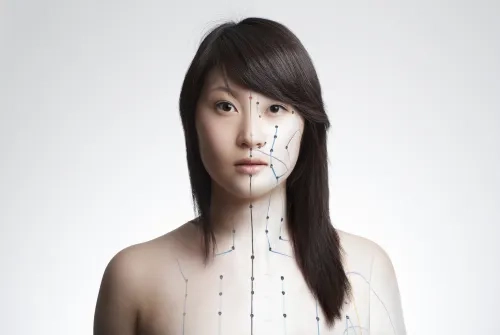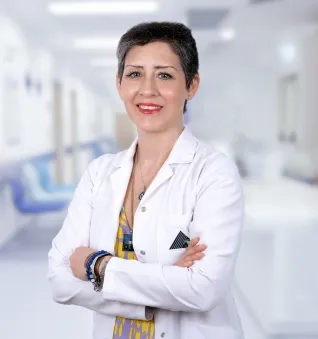Alo Yeditepe
Alo Yeditepe
Acupuncture
Health is seen as the result of the energy balance in the body which is called chi in Traditional Chinese Medicine (TCM). When this energy balance is disturbed, health deteriorates, and diseases occur. There are 12 double and 2 single meridians called energy channels in our body, on which 360 classical acupuncture points are located.
The word “acupuncture” comes from the combination of the words acu (needle) and puncture (penetration), that is, dry needle insertion. Inserting needles into acupuncture points regulates health by restoring the energy balance of chi (chi) flowing along the meridians.
According to the TCM, the reception of a positive De Chi response is considered a sign that the appropriate energy channel has been successfully found. After De Chi is found, the needles are left in place for 20-40 minutes. De Chi sensation may occur more than once at the same point during the acupuncture session. As a new technique that is increasingly being adopted by traditional acupuncturists, the use of electroacupuncture (EA) helps to increase the De Chi feeling.
Meridians
Acupuncture meridians have been named in many languages by international standards. The most widely accepted nomenclature and abbreviations in English are listed below:
LU = Lung Meridian
LI, CO = Large Intestine Meridian
ST = Stomach Meridian
SP = Spleen Meridian
HT, HE = Heart Meridian
SI = Small Intestine Meridian
BL, UB = Bladder Meridian
KI = Kidney Meridian
P, PC, HC = Pericardium, Heart Constrictor Meridian
TW, TH, SJ = Triple Warmer, Tri-Heater, Triple Burner, San Jiao meridian
GB = Gallbladder Meridian
LV, LI, LIV = Liver Meridian
CV, VC, Ren= Conception Vessel Meridian
GV, VG, Du = Governing Vessel Meridian
The abbreviations LI and CO were used in some older books for the liver and large intestine, respectively.
Clinical Effects of Acupuncture: Methodological Considerations
The methodological quality of many randomized clinical trials evaluating acupuncture is inadequate. The major problem in these studies is the lack of an adequate placebo control. Sham acupuncture is used as a common control procedure. Accordingly, the needles are inserted into unsuitable meridians or areas outside the meridians. In sham acupuncture, more superficial needle insertion is frequently performed than in the real acupuncture group.1 Linde et al. conducted a meta-analysis of 37 randomized controlled trials evaluating acupuncture. In this analysis, they compared sham with placebo acupuncture (nonspecific effect) and sham with real acupuncture (specific effect). They stated that sham acupuncture was more effective than placebo acupuncture, and real acupuncture was more effective than sham acupuncture.
Analgesic Effects of Acupuncture
Different hypotheses have been proposed to explain the analgesic effects of acupuncture based on human and animal studies. These effects are complex and largely the result of the interaction of neurochemical, physiological, and psychological factors associated with patients' expectations.
There is evidence to support the role of endogenous opioids (encephalin, dynorphin, endorphin, and endomorphin) and serotonin (5-HT) in acupuncture analgesia. Mayer et al. and Pomeranz et al. showed that Acupuncture Analgesia supporting the role of endogenous opioids was blocked with Naloxone, in mice and humans.
Neural Mechanisms of Acupuncture Analgesia (AA)
Muscle (stimulation of small-diameter nerves)
Medulla spinalis
Chemical transmitters (monoamines such as endorphin, serotonin, NA, etc.)
Midbrain
Blockade of hypophysis pain transmission (Bruce Pomeranz,1987)
Positron emission tomography (PET) studies show increased binding of opioids at mu receptors in the brain after acupuncture. -5- In addition, fMRI has shown activation of the basal anterior brain, the limbic system, and other areas of the brain associated with affective and somatosensory functions with acupuncture treatment.
The role of Capicolaminas and Cerotoninas which are effective cerebral neurotransmitters, in acupuncture analgesia is under research. The release of these neurotransmitters can produce analgesic, muscle relaxation, anti-inflammatory, mild anxiolytic, and antidepressant effects. Electroacupuncture generates CXCL 10 at the inflammation location and stimulates antinociception via peripheral opioid peptides.
Endogenous opioid peptides such as beta-endorphin are associated with acupuncture analgesia. They activate opioid receptors in the spinal cord, as in peripheral sensory neurons in the peripheral inflammatory area. Opioid-containing leukocytes migrate to the inflamed tissue and secrete opioids such as endorphin, met-encephalin, and dynorphin A.
Thus, they form antinociception by binding opioid receptors on peripheral nociceptive neurons.
Indications for Acupuncture Accepted by the World Health Organization in 2003
Backache
Neck pain
Sciatica
Tennis elbow
Knee pain
Shoulder circumference arthritis
Sprains and muscle spasms
Facial pain
TMJ pain
Headache
Toothache
Renal colic
Acute and chronic gastritis
Rheumatoid Arthritis
Initiating the birth
Arrival maneuvers during birth
Morning sickness
Nausea and vomiting
Postoperative pain
Stroke-paralysis
Essential hypertension
Primary hypotension
Leukopenia
Radiation/chemotherapy reactions
Allergic rhinitis
High fever
Biliary colic
Depression
Acute bacillary dysentery
Primary dysmenorrhea
Acute epigastralgia
Peptic ulcer
Nausea and vomiting after surgery and chemotherapy
Toothache
The effectiveness of the American National Institute of Health (NIH) Acupuncture Consensus Development Program alone has been widely accepted.
Acupuncture as adjunctive therapy or an acceptable alternative treatment:
Addiction
Stroke rehabilitation
Headache
Menstrual cramps
Tennis elbow
Fibromyalgia
Myofascial pain
Osteoarthritis
Waist and back pain
Carpal tunnel syndrome
Asthma
Classical Acupuncture Meridians and Points
National Institute of Health (NIH) Acupuncture Final Declaration
However, there are some reservations about creating a control group, placebo, and blind studies due to the form of the method. Nevertheless, the effectiveness of acupuncture has been proven in the suppression of toothache, postoperative and post-chemotherapy nausea, and vomiting. There is very strong evidence that it is beneficial in carpal tunnel syndrome, low back pain, fibromyalgia and myofascial pain, tennis elbow, headache, stroke rehabilitation, and drug addiction.
Cancer Pain
It is stated that Electronic Acupuncture (EA) is also effective in the treatment of pancreatic cancer pain. Chen H. et al. applied EA to T8-T12 bilateral Jiaji (Ex-B2) points of patients once a day for 30 minutes for 3 days. There was a significant decrease in pain intensity in the EA group compared to the control group (p<0.001).
It is stated that there is no difference between the benefits of acupuncture versus conventional medication in nonspecific advanced cancers, the benefits of auricular acupuncture versus placebo for cancer-related chronic neuropathic pain, and conventional analgesia and acupuncture in the first 10 days of treatment in gastric cancer.
Postoperative Pain Management
It is stated that acupuncture reduces pain and opioid use on the first postoperative day. Thus, it is recommended to use acupuncture as adjuvant therapy in the treatment of postoperative pain.
The list of indications published by John McDonald and Stephen Janz, co-authors of the “Acupuncture Evidence Project” in 2017, is as follows:
Areas of Application with Strong Evidence in favor of Acupuncture
Allergic Rhinitis
Knee osteoarthritis
Nausea and vomiting caused by chemotherapy
Prevention of migraine attack
Headache (tension-type and chronic)
Nausea and vomiting after surgery
chronic low back pain
Post-operative pain
Areas of Application with Evidence in favor of Acupuncture
Acute Low Back Pain
Raising The Threshold Of Emotional Perception
Acute Stroke
Neck Pain
Outpatient Anesthesia
Obesity
Anxiety
Insomnia During And After Menopause
Joint Pain Caused By Aromatic Suppressants
Hip Pain
Asthma in Adults
Post-stroke Insomnia
Back And Groin Pain During Pregnancy
Cancer Pain
Shoulder Pain After Stroke
Cancer-Related Burnout
Post-Stroke Muscle Stiffness
Constipation
Post-Traumatic Stress Disorder
Neurosurgery anesthesia
Prostate inflammation and chronic groin pain
Depression (with antidepressants)
Recovery after colon cancer surgery
Dry eye
Restless legs syndrome
Hypertension (with medications)
Schizophrenia (with antipsychotic drugs)
Insomnia
Sciatic pain
Irritable bowel syndrome
Shoulder impingement syndrome (with exercise in the early period)
Labor pains
Shoulder pain
Lateral elbow pain
Smoking cessation (approximately 3 months)
Hot flashes during menopause
Stroke Rehabilitation
Moxa Treatment
Moxa therapy is one of the traditional Chinese medical treatment methods that is done by stimulating the acupuncture points directly or indirectly with the burning dry Artemisia vulgaris (mugwort) plant. It is possible to dissolve pathological cold, and warm meridians, regulate collaterals, stimulate blood circulation, remove the obstruction, support yang, dissolve blood stasis, and prevent diseases, with moxa treatment. Moxa can be used in the treatment of many diseases such as arthritis, gastrointestinal diseases, gynecological problems, and pain. When Moksa is applied, the skin temperature reaches 130 ° C outside and 56 ° C inside. Therefore, moxa is considered an inflammatory response to heat stimulation. The inflammatory response stimulates vascular changes. Vasoconstriction occurs in the skin area where Moksa is applied, and vasodilation occurs around this area. Histamine and substance P is responsible for vasodilation on the skin. The histamine released during moksa treatment causes vasodilation on the skin. As a result of increased permeability, degranulation occurs in mast cells. Substance P and galanin are neurotransmitters released by acupuncture and moxa therapy. These neurotransmitters are known to play a role in neurological diseases such as pain, spasm, anxiety, and depression.
Prof. Dr. İlhan ÖZTEKİN
Yeditepe University Kosuyolu Hospital
Department of Anesthesia and Reanimation Algology
About
Faculty and Year of Graduation:
İstanbul Üniversitesi Tıp Fakültesi (2002)
”
See Also
- Stomach-Duodenum X-ray
- Life Triangle, Not a Bag, Saves Life during an Earthquake
- Pudendal Nerve Compression
- What is Coronavirus?
- A New Record From Turkish Neuro Surgeon
- The True Face of the Protein Myth
- Antibiotics Kill Beneficial Bacteria, Not Viruses
- Allergies in Children Can Increase During the Summer Months
- Cancer Treatment Methods
- What Methods Are Used in Infertility Treatment?
- Hot and Humid Air Affects Our Breathing Quality
- Neurological Involvement
- 3 Major Developments Shaping Treatment in Colon Cancer
- Long Lasting Sore Throat May Suggest Throat (Larynx) Cancer
- Vitamin Deficiency May Cause Dizziness
- Hip Osteoarthritis and Hip Prosthesis
- Allergic Rhinitis Targets People in Big Cities
- Frequently Asked Questions in Thyroid Diseases
- Paternal Prostate Cancer is a Risk Factor for Breast Cancer in Daughter
- Reflux Complaints Have Increased in Babies!
- The Game of Chromosomes
- Let the Bonding Between Mother And Child Not Be Sacrificed for Success!
- Do Not Underestimate Itching!
- Reheat the Food You Cooked Only Once!
- 4 Tips to Boost Your Immunity in Seasonal Transitions
- Pain Control Boosts Cancer Treatment Success by 80 Percent
- High Chance of Treatment in Childhood Leukemia
- Her Maddening Pain Ends with Acupuncture Treatment
- Be Careful When Consuming Sage During Pregnancy
- Even If Your Child is Sick, They Must Take a Bath
- Persistent Headache May Be a Sign of Tumor
- 10 Tips to Help You Get Rid of Your Holiday Weight
- Magnetic Resonance Imaging (MRI)
- Kidney Reflux Should Be Suspected in Children with Urinary Tract Infection
- Daughter-in-Laws Care for Alzheimer's Patients
- Are Pre-School Health Checks Done?
- Why is Headache Important During Pregnancy?
- Which Tests Should Expectant Mothers Not Neglect? What Tests Should Be Done While Pregnant?
- I Was Waking Up With Stomach Pain, I Fell Better After Endoscopic Fundoplication
- Breast Cancer Incidence Age Is Decreasing Day by Day
- Importance of Pneumonia and Flu Vaccine
- Recommendations From The Expert For Migraine Patients
- Eye, Kidney, and Heart Enemy: Hypertension
- Approximately 3 Million Patients Need Blood Transfusions Every Year in Turkey
- Kidney Failure Caused by Ear Obstruction
- Smoking Rates Under the Age of 15 Are Increasing
- Healthy Recipes to Decorate Your New Year's Eve Table
- 15 Ways to Protect Skin During Winter
- Nine Out of Ten COPD Patients Do Not Know They Are Sick
- It Is Possible to Prevent Possible Complications of Intubation
- What Do Suspicious Mammography Results Mean?
- What is Propolis? How to Use Propolis?
- Does an Egg Raise Cholesterol?
- The Tumor in the Trachea was Removed Without Damaging the Vocal Cords
- 63% of Vector-Borne Diseases are Caused by Lyme Disease
- Experts Warn About Flu Risk
- Yeditepe University Produced A Ventilation Device
- Survived from Tumor Covering Half of Larynx With Closed Surgery
- He Walked Out Of The Hospital Where He Entered On Crutches
- Recovered From Thyroid Nodule with Needle Melting Method
- Pandemic Prevents Early Diagnosis of Glaucoma
- Misconceptions about Growth and Development in Children
- One Out Of Every Three People in Turkey is Pre-Diabetes
- Infertility
- Early Menopause
- Blocked Fallopian Tube
- It is also Possible to Lose Weight During the Holidays!
- Which Methods Increase Success in Treatment of Infertility?
- Microinjection
- Pre-implantation Genetic Diagnosis
- The Father Beat Hepatitis B and Cirrhosis with the Liver From His Daughter and Beat The Cancer
- Immune Enhancing Nutrients
- Unnecessary Vitamin and Food Supplements Can Lead to DNA Damage!
- Experts Warn: In Case of Fainting, Consult a Cardiologist First
- Causes of Arhythmia Can be Displayed in 3D
- Quitting Smoking Even After Diagnosing Lung Cancer Effects Lifespan
- Endometriosis
- A Common But Little-Known Disease: Retinopathy of Prematurity (ROP)
- Pay Attention to the Pain That Occurs in the Front Part of Your Knees While Playing Sports!
- Prostate Preventive Cancer Treatment: Focal HIFU
- The Things You Should Know About Prostate Cancer
- They Said It Was Thyroid Cancer, But It Turned Out to Be Parathyroid Adenoma!
- The Process That Leads to Kidney Failure in Young People Progresses Sneakily
- Skin Microbiota May Affect Immunity!
- Beware, These Risks Increase After Menopause!
- Pollen Allergy Has No Season
- How to Prevent COVID-19 in School-Going Children
- Interventional Methods in the Treatment of Acute Stroke
- Breast Ultrasound
- You May Have Leptin Resistance Below Your Constant Desire To Eat!
- Who Is Threatened by Monkeypox?
- Being Thirsty in the Heat Tires the Kidneys!
- Pay Attention to Food Allergies in Children!
- KaryoBaby | Non-Invasive Prenatal Testing (NIPT)
- What Happens at 33 Weeks of Pregnancy?
- What Happens at 30 Weeks of Pregnancy?
- What Happens at 22 Weeks of Pregnancy?
- What Happens at 20 Weeks of Pregnancy?
- What Happens at 17 Weeks of Pregnancy?
- What Happens at 8 Weeks of Pregnancy?
- Nutritional Guide to Strengthen Immunity
- Neurological Problems and Coronavirus
- Considerations for Embryo Transfer
- Aspirin Used Without Physician's Advice Increases Risk of Bleeding!
- What is Lymphedema?
- Curiosities About Breast Cancer
- Osteopathy
- Irritable Bowel Syndrome (IBS)
- Phytotherapy
- One in Three People Has Pre-Diabetes
- Liver Transplant - Frequently Asked Questions
- How to Tell if You Have a Mild Coronavirus?
- Hemorrhoid Treatment
- Breast Aesthetics FAQ
- One in 20 Newborns Have Tear Duct Obstruction
- Scientists Who Glorify the Name of Our Country with Their Contributions to Medical Science
- Injured Athletes Can Return To Sports With Cartilage Transplant
- Goal in Heart Diseases; To reduce the loss of life by at least 25 percent by 2025
- Breastfed Babies Have Lower Blood Pressure, and Their Hearts are Healthier
- Infection Can Cause the Onset of Asthma Disease
- Pay Attention To The Child Who Snores At Least 3 Days A Week!
- 1 in 10 Women Have This Problem; It Can Lead To Infertility
- Technique Developed by a Turkish Doctor Has Become Part of Literature; Is Now an Alternative to Pacemakers
- Hernias in Children Should Be Intervented Without Wasting Time
- Eye Problems Increase as Children's Digital Screen Time Extends
Alo Yeditepe



